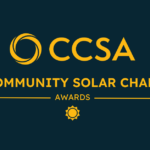A successful night for community solar’s path forward
While presidential elections may nab more headlines, midterm elections are crucial to influencing clean energy policy momentum both on a state and national level. This year’s midterm cycle was no different, with numerous races seeing surprise state-level legislature swings and shifting representation that will have ramifications on the broader community solar movement. Overall, it was a good night for community solar with most races breaking favorably and putting states with active community solar legislation or policy in position for continued success. Let’s take a look at some of the major takeaways:
Governor Races’ Results Favor Community Solar. Community solar advocates across the U.S. were pleased to see numerous pro-solar Governor candidates win elections, including all of the races deemed close by the pundits in Arizona, Maine, Michigan, New Mexico, New York, Pennsylvania, and Wisconsin, among others.
“Governors play a critical role on community solar policy because they can influence and even dictate policy priorities to the legislature, they appoint commissioners to serve on their state’s public utilities commission, which have regulatory jurisdiction over our issue, and they ultimately can veto bills they don’t like,” said Matthew Hargarten, VP of Campaigns at the Coalition for Community Solar Access. “We’ve already seen the positive outcomes that a pro-community solar governor can produce, as they have used their political capital to press their legislatures and agencies to create a long-term vision for community solar.”
More Legislative Trifectas. Aligning the legislative and governors’ office along one party line can often result in more efficient policymaking and implementation of community solar. That’s why it was welcome news last week when four new trifectas emerged in high-potential markets for community solar. Minnesota and Michigan both flipped the state legislature and held onto the governor’s mansion, while in Massachusetts and Maryland, they both held onto the legislature and flipped the governor’s mansion. This outcome was particularly unexpected in Michigan, where the legislature has been controlled by the Republicans for over a decade and most onlookers didn’t predict a full Democrat sweep. A trifecta doesn’t mean bills will magically start passing, but it’s always easier to get things done with a single party in charge. A great example is New York, with Governor Kathy Hochul continuing to helm one of the country’s most ambitious and successful community solar markets and its ambitious 10 GW of distributed solar roadmap underway.
Quick Hits: Around the Nation by Region
Mid-Atlantic. While the majority of the Mid-Atlantic states did not hold elections this cycle, Maryland’s selection of Governor Wes Moore coupled with Democratic majorities in both chambers will likely usher in a more proactive era of renewable energy policy. Delaware Senator Stephanie Hansen, a strong community solar champion, ran unopposed and Virginia’s Republican Governor has specifically called for additional support for community (shared) solar within his 2022 Virginia Energy Plan.
Midwest. One of the biggest surprises of the election cycle may have been Michigan, as it’s been decades since the Democrats have controlled the House, Senate, and Governor’s office. That should lead to more opportunities for renewable energy interest groups and state unions. In Wisconsin, Republicans maintained their control of the Assembly and Senate as expected, while Tony Evers maintained Governorship and will have the ability to fill seats at the public utility commission. Not much changes in the Illinois legislature with Democrats continuing to control all branches of government and are in somewhat uncharted territory with the state budget crisis largely handled. In Ohio, the Republicans maintained control of all three branches of government and continue to show a desire to advance conservative driven, pro-economic development renewable energy policies.
“As states across the country face unprecedented energy prices and consumers are hit hard by inflation, calls for more community solar from both sides of the aisle continue to grow,” said Hargarten. “Increasing access to community solar within states can lead to more consumer choice, strong job creation, and more energy independence — that’s good news for people of any political stripe.”
Mountain West. Minnesota, in a bit of a surprise from what the experts were predicting, saw Democrats take control of both chambers and the Governorship which could have interesting implications on one of the country’s oldest community solar programs. Expect continued strong support for renewables and community solar throughout Colorado, from Governor Polis and strong leadership that will continue in the state’s House and Senate. In New Mexico, Governor Michelle Lujan Grisham survived a strong push from her Republican challenger to keep a democratic trifecta in place in a state that has its community solar program officially coming online in 2023. In Arizona, Democratic Governor Katie Hobbs won the Governorship, while Republicans picked up one seat on the Arizona Corporation Commission giving them a 4-1 majority.
Northeast. Maine, part of the legislative trifecta club, can continue its work on increasing new and supporting existing solar programs with Governor Mills at the helm. Citing an uptick in community solar in the state during her campaign, expect Governor Healy of Massachusetts to usher in a commitment to reforming and expanding the state’s solar programs, particularly with an emphasis on climate and environmental justice. As mentioned, New York will continue being a leader in the community solar space with its legislative trifecta remaining intact.
West. California, which recently passed community solar bill AB 2316, is seeing a number of legislative changes that could prove ripe for community solar. The Utility Commission appointment will not be determined until January and Governor Newsom will continue to prioritize affordable and stable electricity for all Californians while reshuffling some of his top aide positions.
Overall, the election cycle brought more optimism to an already-strong year for community solar around the country. As legislative sessions begin in the early parts of 2023, it will be important to look out for how various states’ commissions, politicians, and advocates work together to both prioritize earmarked funding from the IRA and local priorities to push community solar policies forward.




